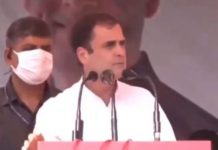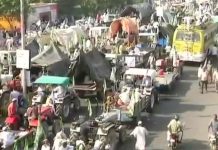
A CLOSE UP of oars easing through water. A voice says, “Abhi light bahut sahi hai.” Cut to a man in a boat wielding a knock-off Givson guitar and a 1000 Watt smile. Rushnaf Wadud is the lead vocalist for Chittagong-based Blunderware, who actually call themselves a BARFI band (Blues, Alternative, Rock, Folk, Indie). He’s at the Okhla Barrage in Delhi to shoot a video for the Tehelka Music Project. The web series, started by TEHELKA in late 2010, to discover new acts and provide a platform for independent music in India, completes 50 episodes this week.
As the sun sets and the boat passes by the feather reed fields, Wadud breaks into Afim Chaash, his band’s only single, which he says he wrote on a napkin. He sings, in Bangla, “I farmed my heart in search of opium, and only my heart understands the intoxication.” Unusual lyrics, unstructured staging, largely unknown performers; the Tehelka Music Project now occupies the intersection between college battles of the bands, late-night jam sessions in basements and bars, amateur YouTube videos, and a burgeoning interest in independent music. “Having followed similar shows in France and England — Une Soirée de Poche, The Black Cab Sessions, A Take Away Show and Watch Listen Tell — I wanted something similar for Indian acts: the proverbial ‘scene’,” says creator Andrew Clarance. “There wasn’t any dearth of content or talent. It was all just waiting to be tapped.”
Independent music web-zine NH7, which conducts the famous Weekender Music Festival, was the first to pick up on the series, asking readers to watch the show for the “deftly recorded audio”. NH7 editor-in-chief Arjun S Ravi says that the production quality has now improved with time. “DSLR technology has allowed musicians to shoot really compelling videos, and the team has exploited it really well.” He loves the honesty of the episodes, “The edits retain the awkwardness of the bands’ introductions, which I thought was really cool. Andrew has taken a simple idea and added character to it.”
As television executives woke to the growing market of a generation itching for better music by introducing shows like Coke Studio India and The Dewarists, the Project was already up and running. Instead of the studio or palaces in Rajasthan, the team shot in warehouses, in quiet bookstores, in parks with onlookers, in hotel rooms, by the sea, on rooftops, in abandoned bungalows and even the TEHELKA basement. The basement, a Twilight Zone few venture into, is filled with old issues, cobwebs and old furniture. Very apt for Sulk Station, an electronic/triphop duo from Bengaluru. Soon the Project was being mentioned alongside prominent music shows. Tossed Salad, an independent lifestyle website from Pune called it the “true indie show”. And as Clarance puts it, indie cred is everything.
THE BIG-BUDGET TV shows made household names of formerly unknown acts. But Clarance felt that the Project would not work on that scale, choosing to use YouTube instead as his medium. He felt it was democratic. He also felt that the intimacy of the visual portraits, as he calls the episodes, could not be recreated on television. Those decisions became a structural framework for the project, supporting its spontaneity. “At the Asian Bands Festival one of my colleagues spoke to The Mekaal Hasan Band. The next thing we know, we are in their hotel room setting up sound and camera for a shoot. Between cups of tea and impromptu jam sessions, we spoke at length about ‘Sufi rock’ and the problem with that term, the music scene in Pakistan and about Kailash Kher’s ‘Sufi’ music. We got out late at night after the shoot, equipment and guitars in hand, realising we really had something which excited us and would also be something completely brand new to the Indian music scene.”
Arijit Datta of Airport, a Hindi pop-rock band, says appearing on the Project helped them expand their fan base beyond Mumbai where they are based. “The song we recorded received tremendous support,” he says. “When we came to Delhi for a gig, many requested that song. They bought tickets because they had heard us on the Tehelka Music Project.”
“It’s not like a band will perform for the project and immediately be headlining music festivals,” Ravi says of the impact of the Project. “But I think anyone who watches all 50 episodes will find at least 40 acts they have never heard of before,” he adds, “and they will fall in love with at least a few of them. It’s a phenomenal showcase of new acts who get very little exposure in India. I’m envious of them; I wish NH7 had started a Music Project of its own.”
Hari and Sukhmani, a Chandigarh-based Punjabi folk act, were shot on a rooftop on a cold December night. The location, decked with lightbulbs, candles, fairy lights and lanterns was a magical, if not entirely authentic, recreation of a winter night in rural Punjab. “It was elegant, raw and simple,” says Hari Singh. Two weeks ago, the band made an appearance in the season finale of Coke Studio. “This,” Clarance says, “is what we wanted the Project to be. A catalyst.”
ajachi@tehelka.com












